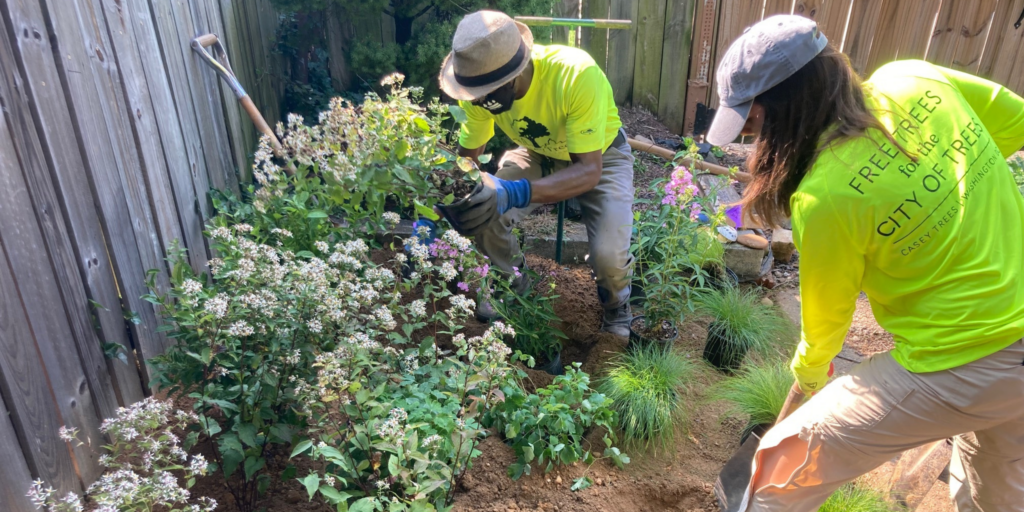
Whenever people ask what they can plant to support pollinators, I always say asters. Versatile, beautiful, and easy-to-grow, asters provide color and interest (as well as nectar for bees and other insects) long after many other perennials have gone to seed. They are also bulletproof, hardy plants that can survive all sorts of challenging garden conditions, including shade, drought, blazing sun, high pH, heavy clay, and rocky, low-nutrient soils. Plus, they’re deer resistant!
Asteraceae, or the daisy family, is one of the largest families in the plant kingdom, encompassing over 30,000 species of flowering plants. The native species of what we know and recognize as asters here in North America come from seven genuses within this giant family: Symphyotrichum, Eurybia, Ionactis, Seriocarpus, Doellingeria, Ampelaster and Oclemena. In Casey Trees’ garden installations, we always try to include at least one species of aster to provide late-season forage for pollinators, larval food for butterflies and moths, and a dose of much-needed fall color.
Note that most asters in a garden setting will benefit from a mid-season “haircut” in June, July, or August (depending on their specific bloom time) to encourage them to adopt a more manageable shape and size for garden settings; to do it, simply cut foliage back about one third to halfway with clean pruners. In settings where your asters are growing especially vigorously, you can do this twice about a month apart in summer: in June and July for early bloomers, and in July and August for later bloomers. For a “wilder” look, they can be left unsheared and allowed to ramble.
If you’re looking for something to plant this fall, you can’t go wrong with one (or more!) of the attractive, underplanted, and dependable native asters listed below. All of these can be readily purchased at natives-only nurseries or online from a site such as Izel Plants.
Heartleaf aster – Symphyotrichum cordifolium
An excellent aster for dry shade conditions, heartleaf aster is an early fall bloomer that shows off starry flowers in shades of pale blue to lavender, readily reseeding itself in favorable conditions. Cultivar ‘Avondale’ is an exceptionally prolific selection of this species.
Heath aster – Symphyotrichum ericoides
Named for its preference for rocky ledges and poor soils, heath aster can be found growing wild by the side of the road, but it also makes an attractive and drought-tolerant addition to a full-sun garden. Cultivar ‘Snow Flurry’ grows low to the ground and is especially tumbling over retaining walls or boulders.
Smooth aster – Symphyotrichum laeve
A carefree addition to a meadow planting or full-sun setting with well-drained soil, smooth aster naturally occurs in open glades and prairies. Its pale blue florets have golden-yellow centers and are produced in profusion. Cultivar ‘Bluebird’ was ranked #1 by Mount Cuba Center in its aster test trials, scoring highly for hardiness and flower production.
Calico aster – Symphyotrichum laterifolium
This special aster produces a dense twinkling of tiny white flowers along the length of each of its woody stems. Tolerant of poor soils and part shade, it is a failsafe choice for wildlife and pollinator gardens. Cultivar ‘Lady in Black’ has dark stems, purple leaves, and pink-centered flowers produced en masse throughout the month of October.
Aromatic aster – Symphyotrichum oblongifolius
Named for its fragrant foliage that gives off a spicy aroma when crushed, this is a bushy, exuberant aster for full-sun settings that is carpeted in large neon-purple blooms come late fall. It is tolerant of drought and high pH, and pollinators adore it. Cultivars ‘Raydon’s Favorite’ and ‘October Skies’ are more floriferous than the straight species.
White wood aster – Eurybia divaricata
This delicate woodland aster produces sprays of white flowers beginning in late September. Perfect for dry shade settings such as under big trees where little else will grow. (If you choose to plant it there, we recommend installing smaller size plants, such as plugs, to avoid too much root disturbance.) Cultivar ‘Eastern Star’ is shorter than the species but does not come true from seed.
Big-leaved aster – Eurybia macrophyllus
Named for its large spade-shaped leaves, this shade-tolerant aster provides textural variety in understory settings with well-drained soils. White, spidery flowers appear in late September. Cultivar ‘Twilight’ is a naturally occurring cross between macrophyllus and spectabilis and offers up a profusion of starry blue flowers borne on red-tinged stems.

